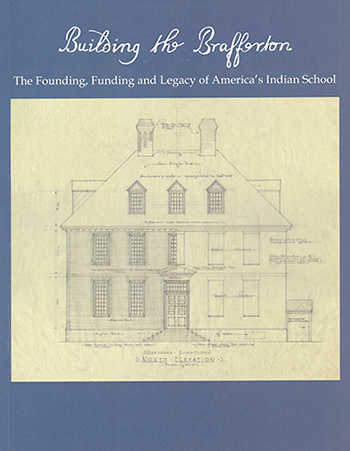The Founding, Funding and Legacy of America’s Indian School
 An extraordinary new volume from the Muscarelle Museum of Art reframes the history of William & Mary's Brafferton Indian School. Authors Danielle Moretti-Langholtz and Buck Woodard conducted more than a decade of anthropological, archival, and material culture research and uncovered a story that is entwined with trans-Atlantic trade, ecclesiastical networks, and British efforts to forge alliances with Native nations. The publication was funded in part by the Arts & Sciences Annual Fund.*
An extraordinary new volume from the Muscarelle Museum of Art reframes the history of William & Mary's Brafferton Indian School. Authors Danielle Moretti-Langholtz and Buck Woodard conducted more than a decade of anthropological, archival, and material culture research and uncovered a story that is entwined with trans-Atlantic trade, ecclesiastical networks, and British efforts to forge alliances with Native nations. The publication was funded in part by the Arts & Sciences Annual Fund.*
Departing from previous scholarship on the Indian school, in a decolonizing effort to foreground Native perspectives on this complicated history, the research was rooted in civic engagement with historically-linked Native communities.
An outcome of the research has been an onoing effort to reconnect William & Mary to Brafferton descendant communities with historic links to the Indian school. A Brafferton Legacy Group, convened before the 2011 renovation of the building, included Eastern Band of Cherokee, Chickahominy, Meherrin, and Pamunkey alumni of W&M. The legacy group held a public ground-blessing ceremony to honor the Native students who once studied at the school. Native archaeologists assisted with excavations and participated in the building's rededication ceremonies.

Building the Brafferton ... serves as both catalogue for the companion 2016-17 Muscarelle Museum exhibition and as a major, standalone body of scholarship. Three broad sections shape the volume.
The Founding section sorts through the previously murky origins of the Indian school to uncover a story whose "history is buried in the faded and fragmentary ledger books, legislative acts and church correspondence of the era."
 The Funding section foregrounds new information about select Brafferton students, including their subsequent adult roles and contributions, and honors the living memories carried among Native descendant communities whose young men attended the school.
The Funding section foregrounds new information about select Brafferton students, including their subsequent adult roles and contributions, and honors the living memories carried among Native descendant communities whose young men attended the school.
A timeline is set forth, beginning with the 1693 William & Mary charter and continuing to the present day.
Timeline of Significant Events1693 Royal Charter includes the text, “that the Christian faith may be propagated amongst the Western Indians,” understood as referencing all Native peoples in English-occupied North America. c. 1702 Four young Indian captives, purchased by agents of Governor Nicholson from the Catawba, become the first known Indian students. They were not kept as slaves. In the early years of William & Mary, the “Indian student body equaled one-third to one-half of all pupils on campus.” 1712 The highest number, 24, of recorded Indian students. “During the subsequent decades, enrolled students seemed to hover from four to eight young men at a time.” 1723 The Brafferton building is completed (before completion of the Chapel and South Wing of the Wren Building, and before construction begins on the President’s House). 1734 The building is modified to include dormers and living space on the third floor and a library on the second floor. 1778 With the departure of Henry Bawbee, “the Brafferton Indian School ceased to have Native students.” 1932 First restoration of the Brafferton, during the Rockefeller era. 2011-13 Second restoration of the Brafferton; Brafferton Legacy Group formed in 2011. 2016-17 The Muscarelle Museum hosts the Brafferton exhibition. William & Mary launches a Native Studies academic minor. 2018 William & Mary asks Dr. Ashley Spivey (Pamunkey) to serve as the first Tribal Liaison for the university. 2019 Publication of the Brafferton edited volume. |
The Legacy section showcases documents, archaeological finds, and aspects of the building's 1930-32 restoration work.
Today upwards of 50 federal, state, and non-recognized tribes can be linked to Native students who attended the Brafferton. For Moretti-Longholtz and Woodard, a surprising take-away from their discussions with tribal partners was their understanding that the Brafferton Indian School was viewed by many indigenous communities as distinctly different from other Indian schools of the nineteenth century. While the school was a British colonialist endeavor, alliances with Native tribes were an essential part of the Brafferton's role in British diplomacy and empire-building.
Kate Conley, Dean of Arts & Sciences, congratulated the volume's scholars on their work: "Through their efforts, we continue to uncover an important and nearly forgotten story. And the substantial publication ensures that this knowledge will endure as part of the scholarly heritage available to future generations."
Related story: The legacy of America's Indian School: Remembering a forgotten history
*Funding was also provided by the Department of Anthropology, Swem Library's Special Collections Research Center, the Provost's Office, and the Muscarelle Museum of Art.
Note that unattributed quotations are from the volume: Moretti-Langholtz, Danielle & Woodard, Buck. Building the Brafferton: The Founding, Funding, and Legacy of America's Indian School. William & Mary, 2019, print, 318 pages. Available for purchase at the Muscarelle Museum of Art, $40 members, $45 non-members.














